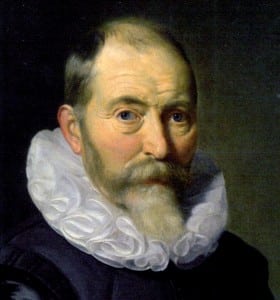Willem Janszoon was a Dutch navigator and colonial governor. Janszoon served in the Netherlands East Indies in the periods 1603–11 and 1612–16, including as governor of Fort Henricus on the island of Solor.

He was the first European to see the coast of Australia during his around-the-world voyage of 1605 - 1606.
Jump to:
Willem Janszoon Facts: Early Life
Willem Janszoon's early life is unknown, except that he was born in 1570.
The first record of Janszoon was his entering into the service of a trading company.
He joined the fleet aboard the Hollandia as a mate and journeyed to the East Indies.
Janszoon sailed to the East Indies three times, and on the third trip, he was named captain of the Duyfken.
During this voyage, he searched for other outlets of trade in the land of New Guinea.
Willem Janszoon Facts: Australia
On November 18, 1605, the Duyfken sailed from Bantam to the coast of western New Guinea. Janszoon then crossed the eastern end of the Arafura Sea, without seeing the Torres Strait, into the Gulf of Carpentaria.
On February 26, 1606, he made landfall at the Pennefather River on the western shore of Cape York in Queensland, near the town of Weipa. This is the first recorded European landfall on the Australian continent.
Janszoon proceeded to chart some 320 km of the coastline, which he thought was a southerly extension of New Guinea.
Finding the land swampy and the people unfriendly (ten of his men were killed on various shore expeditions) at Cape Keerweer ("Turnabout"), south of Albatross Bay, Willem Janszoon decided to return and arrived at Bantam in June 1606. He called the land he had discovered "Nieu Zeland," after the Dutch province of Zeeland, but the name was not adopted and was later used by Abel Tasman for New Zealand.
The Duyfken was in Torres Strait in March 1606, a few months before Luís Vaz de Torres sailed through it. In 1607 Cornelis Matelieff de Jonge sent him to Ambon and Banda.
In 1611, Janszoon returned to the Netherlands believing that the south coast of New Guinea was joined to the land along which he sailed, and Dutch maps reproduced this error for many years.
Though there have been suggestions that earlier navigators from China, France, or Portugal may have discovered parts of Australia, the Duyfken is the first European vessel definitely known to have done so.
Janszoon reported that on 31 July 1618, he had landed on an island at 22° South with a length of 22 miles and 240 miles SSE of the Sunda Strait. This is generally interpreted as a description of the peninsula from Point Cloates.
Willem Janszoon Facts: Political Life and Death
Janszoon arrived back in the Netherlands in approximately 1617 and was appointed as a member of the Council of the Indies.
He served as an Admiral in the Dutch Navy and captured four ships of the British East India Company.
In 1620, he was one of the negotiators with the English. In a combined fleet, they sailed to Manilla to prevent Chinese merchants from dealing with the Spanish. Janszoon became vice-admiral in the year after admiral. At the end of his life, Janszoon served as governor of Banda (1623–27).
He returned to Batavia in June 1627 and soon afterward, as admiral of a fleet of eight vessels, went on a diplomatic mission to India.
On 4 December 1628, he sailed for Holland and, on 16 July 1629, reported on the state of the Indies at The Hague. He was probably sixty years of age and willing to retire from his strenuous and successful life in the service of his country.
Like his early years, the later years of Willem Janszoon's life are unknown. Most believe he died in 1630.
